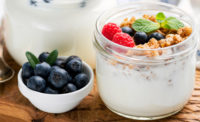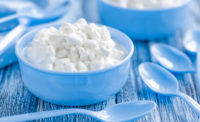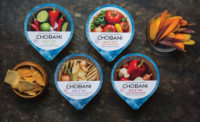Seen from a certain angle, any challenge can resemble an opportunity. And by that reckoning, contemporary dairy developers are living in a land of opportunity, indeed — for whether they’re cleaning labels, cutting costs or contending with the parade of plant-based products crowding the dairy space, research and development (R&D) teams have been handed some challenging lemons.
If only a magical ingredient would descend from the skies to make turning those into lemonade so much easier.
Alas, that magical ingredient won’t be forthcoming. But the good news is that it doesn’t have to be, as R&D labs across the country already stock a handful of workhorse ingredients that, though not magical, have multitasking practically written into their DNA.
Which ingredients? Cultures and enzymes. No, they’re neither new nor sexy, but their functional chops help dairy formulators transform today’s most pressing challenges into innovation opportunities. And that might be all the magic dairy developers need.
Modern problems
You could hardly blame the dairy industry for hoping a little magic might be in order. After all, we have a lot on our plates these days.
“Dairy customers come to us with different types of projects, including improving product characteristics, standardization of those characteristics, shelf-life stability, improving management of production, reducing noncompliance with standards, new product development and improving and optimizing yields,” noted Erik Kai, who works in business development for Codex-ing, Miami.
In other words, ever-evolving trends and the demands of a global market mean that dairy formulators can’t just formulate and call it a day. They have to answer to a variety of constituencies — both internal and external — bearing a variety of concerns.
Consider health and wellness.
“Today’s savvy consumers are more aware of health than ever, and this has led to an increase in demand for dairy foods and beverages with health and wellness benefits,” said Nicolas Touillon, business director for dairy, DSM Food Specialties, Delft, Netherlands. “Lactose-free and low-sugar dairy products are all growing in popularity, and products with increased nutritional value or added functionality — such as satiety promotion — are also gaining traction.”
Concomitant with their preference for health and wellness is consumers’ pursuit of “transparent, short and comprehensible ingredient lists,” Touillon continued, as well as their increasing loyalty to companies that pay more than lip service to sourcing and manufacturing traceably and sustainably.
Of course, none of this suggests that consumers have downgraded convenience, which still drives purchase decisions. Half of the respondents to a DSM consumer breakfast insights survey claimed to spend fewer than 15 minutes on breakfast, with one-quarter sparing fewer than five minutes.
“So consumers are looking for convenient products, too,” Touillon said, “including dairy formats that stay fresh and can be consumed on the go.”
All in a day’s work
That’s a tall order to fill. But as category experts are quick to note, it’s all in a day’s work for a strategically chosen culture or enzyme.
“Given that the industry is continually evolving, I see that the demands are for ingredients that can produce consistent performance and improve the efficiency of milk conversion to finished products,” observed John Lyne, director, dairy technology for Chr. Hansen, Hoersholm, Denmark. So cheesemakers, for example, lean on cultures and coagulants to maximize operational efficiency so they can compete in global markets.
“Product developers come to us with either problems they’re facing or an idea for an end product that they don’t know how to get to,” said Christina S. Barsa, a Certified Food Scientist who is a technical sales representative for Enzyme Development Corp., New York.
And here, she said, enzymes can help.
“Enzymes are essential to many products,” she noted. “They’re needed to produce certain flavors, textures or added functionalities. They may not be what you notice in there, but when they’re left out, it’s noticeable that something’s not right in the product. So customers may know they need an alternative lipase, but they don’t know which will give them the flavor profiles they’re looking to achieve.”
Get more from less
That’s why it’s so important to work with suppliers that appreciate enzymes’ and cultures’ problem-solving potential — and can help you realize that potential in your own formulations.
“Nowadays, from a technological point of view, it’s possible to create almost anything,” Kai pointed out. “But only lactic acid bacteria can use the compounds in milk to create something different through the process of metabolism.”
That’s why he sees them as critical tools for optimizing operational efficiency.
Consider pasta filata production, where “the right management of dairy cultures’ biological process allows for an increase in yield,” Kai said. “Thanks to the reduction of proteolytic activity, it’s possible to increase the quantity of moisture without changing the product characteristics during shelf life. That means it’s possible to obtain more product using the same amount of milk.”
Touillon also appreciates cultures’ contribution to efficiency.
“One challenge our customers face is striking a balance between staying on trend with consumer demands while ensuring efficient production to achieve the necessary returns required for sustainable business success,” he said.
Because phage contamination is a common — and costly — headache for cheese producers, manufacturers need cultures that come in efficient rotations and are phage-robust, Touillon explained.
“Effectively managing phages allows manufacturers of cheese and fermented milk products to efficiently produce high-quality dairy foods and beverages to maximize profit,” he said.
Enzymes help dairy producers squeeze more value out of their raw materials, too. DSM’s Maxiren XDS coagulant, a liquid chymosin derived from a select strain of the dairy yeast Kluyveromyces lactis, targets proteolytic activity to support the ripening process, increase efficiency and produce cheeses that are more sliceable and flavorful. Especially suited to mozzarella, cheddar and string cheese, the enzyme improves production flexibility.
“As the cheese’s texture is retained, shredding, dicing and slicing can take place effortlessly and efficiently at any point during shelf life,” Touillon said. “This reduces losses that occur during slicing by up to 15% and increases the water content of the finished cheese by approximately 1% — all while retaining the same high quality customers expect.”
Chr. Hansen’s chymosin coagulant, named CHY-MAX Supreme, offers cheesemakers up to 1% higher yield — thanks to better fat and protein recovery — and faster, more precise production. All of this lowers production costs and reduce waste while improving functionality, said Lyne.
The ingredient improves the value of the resultant whey as well, leaving behind more of the valuable intact whey proteins — and fewer casein-derived proteins — after protein hydrolysis. And by increasing fat retention in the cheese itself, less winds up in the whey. Trials with continental-style, cheddar, pasta filata and queso fresco cheese applications in both large- and small-scale plants have yielded what Lyne described as excellent results.
“Together, these changes mean a higher quality of whey that can command a higher price in the market and be used in the making of premium products such as sports drinks and infant formula,” he said.
All in good taste
Today’s cheesemakers are under pressure to produce more, Lyne noted. But if value generation comes at the cost of taste and flavor, it’s of little value at all.
Fortunately, cultures and enzymes can help here as well.
“Taste develops over time,” Touillon noted, “and by selecting the right cultures, cheesemakers can slow the taste-development process or keep it stable for the product’s shelf life, preventing its taste from intensifying.”
Strategically deploying cultures to accelerate ripening is another option for getting a cheese to its goal profile in less time, he added.
And when targeting a specific varietal flavor like Continental Castellano, Gouda or Edam — or even when trying to build indulgent, creamy appeal into a low-fat product — cultures, Touillon said, are the most effective solution. His company’s DelvoCheese CT-Light helps produce low-fat and low-calorie continental cheeses with the same diacetyl notes and creamy textures as their full-fat models, “meeting growing consumer demand for premium, authentic and artisan cheese types without having to compromise.”
Further, the recently introduced DelvoFresh YS-140 culture lets dairies create rich and creamy yogurts and desserts with a mild taste. It produces a fast fermentation and limited post-acidification at 5 degrees Celsius, so the finished product stays mild throughout its shelf life.
Suitable for plain or flavored stirred yogurts, it “can support dairy manufacturers in meeting the rising consumer demand for premium yogurts with functional benefits while delivering the mild and creamy taste consumers associate with indulgent foods,” Touillon said.
Bring taste and health together
Hitting that nexus of great taste and functionality isn’t easy. But cultures and enzymes help smooth the path — and just in time.
“Dairy manufacturers today are being challenged by a variety of groups, from health organizations and governments to retailers and consumers, to reduce sugar in foods,” Lyne noted.
In response, his company launched Sweety Y-1, which Lyne billed as “the first culture in the world that allows dairy manufacturers to create naturally sweeter products while reducing added sugar.” The culture promotes a very low post-acidification, reducing the need to balance taste with added sugar while also “unlocking” milk’s own natural sweetener: lactose.
“It can convert the existing sugars in milk,” Lyne explained, “using more of the lactose to yield glucose, which provides a greater sweetness intensity. This means you can add less sugar and still get the same sweet-tasting product.”
This speaks directly to consumers’ desire to have it all: great taste, clean labels, less sugar and an overall feeling of wellness warm-fuzzies.
That same health-and-wellness desire also drives the plant-based wave swamping supermarkets and striking fear into dairy brands that see their turf being encroached upon. But for brands taking an “if you can’t beat ‘em, join ‘em” stance, there’s an enzyme for you, too.
“Over the last couple years, we’ve seen a push in the dairy industry to be more vegetarian-friendly,” Barsa observed. “For products like cheeses, we see a lot of research into alternatives to the traditional animal lipases.
“In a way, this is both a challenge and an opportunity: The challenge is finding alternative products that give the same flavor profiles to the cheese,” she added. “However, in the process, new types of cheese are being developed that have new and interesting flavor profiles. These alternative flavors and forms are opening up the cheese market to a broader range of consumers.”
Case in point: Barsa’s company produces a rennet from thistle flower that qualifies as vegetarian, kosher, halal and non-GMO and yet produces a blue-cheese-like flavor in a cream-cheese-based product.
“The biggest challenge is that perception of the specific flavor seems to vary with the test group’s expectation of blue cheese,” she said.
The bigger picture
As dairy manufacturers struggle to balance taste, wellness, operational efficiency and more, is it too much to ask to make room for issues such as food safety, or even food waste?
Hopefully not.
“Solutions for reducing food waste, preventing spoilage and increasing shelf life have become crucial in the dairy-production process,” Touillon said. “Dairy companies that do this well and market their efforts in this space can benefit from the halo of being good — and talking about it.”
Hence the interest in solutions that approach safety, spoilage and waste via a “bioprotection” or “biopreservation” angle.
“Bioprotection prevents food spoilage by using microbial food cultures to inhibit unwanted contaminants,” Lyne said. “[Using cultures this way] can help strengthen the trust of retailers and consumers in brands naturally, without the use of unwanted artificial ingredients.”
As an example, DSM’s DelvoGuard protective cultures prevent yeast and mold growth in dairy, Touillon said, reducing microbial spoilage and extending shelf life without compromising taste or texture.
Kai is also bullish on clean-label protective cultures, which can be used to prolong shelf life and preserve fermented dairy products.
What else does he have his eye on? Cultures that exhibit low proteolytic activity, which help stabilize fresh products over the course of their shelf life.
So watch this space. There’s no need to believe in magic; cultures and enzymes have a power that’s real.






